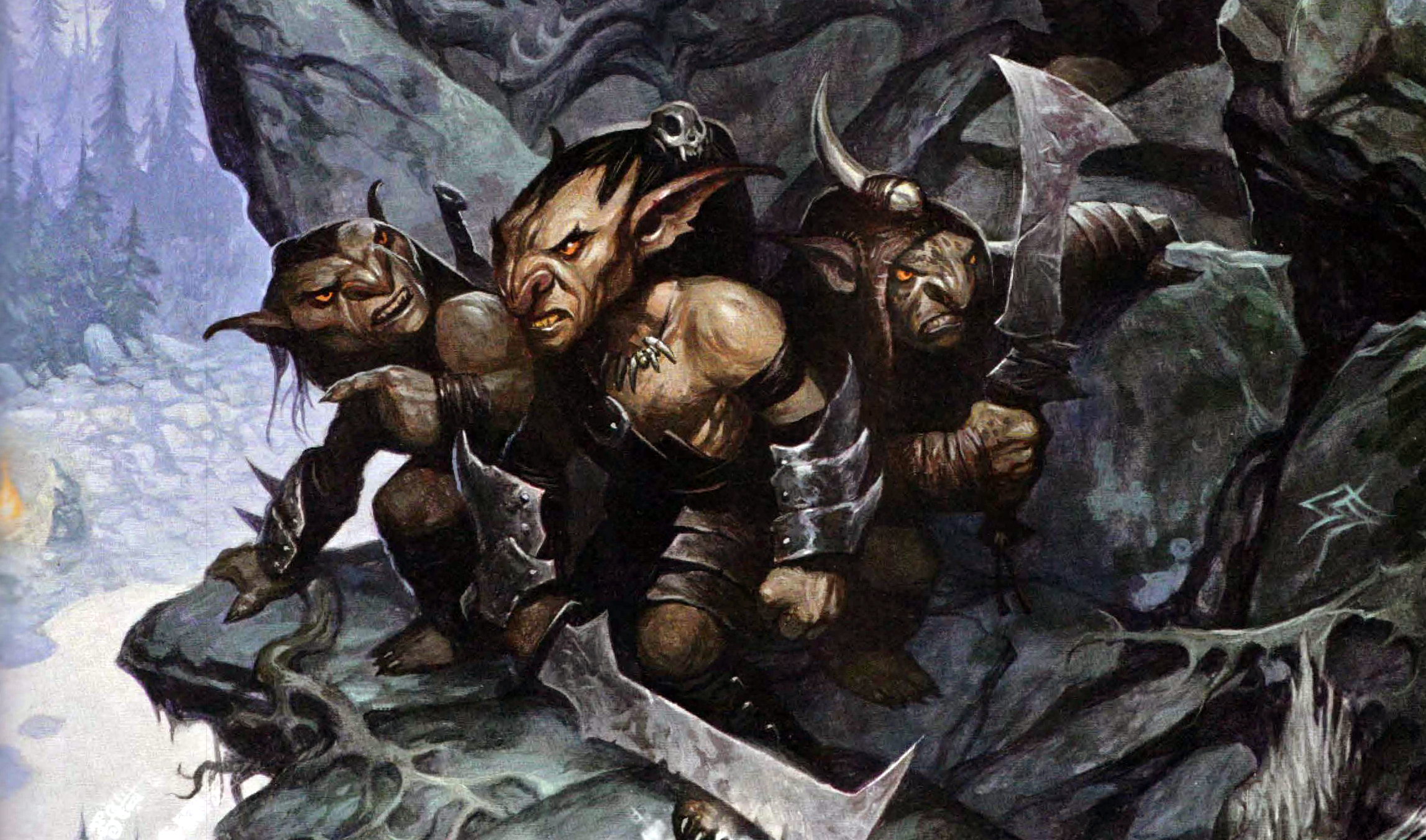The core structure of Phase 1 is fairly straightforward:
- The PCs arrive in Nightstone and discover the town badly damaged by a cloud giant attack, abandoned, and infested with goblins.
- After discovering that the townspeople evacuated to the nearby Dripping Caves, the PCs go to the caves and rescue them from the goblins who have taken them prisoner.
- The PCs receive (in the Remix) adventure hooks pointing them towards Bryn Shander, Goldenfields, and Triboar (see Part 3A).
And that should basically wrap things up.
… except it doesn’t.
After the PCs clear out the goblins in Nightstone, the village is immediately attacked by a completely unrelated group of orcs. And then, after the PCs fight off the orcs, the village is immediately attacked AGAIN by a group of Zhentarim mercenaries.
So, to sum up, in just a couple of days Nightstone has been independently assaulted by cloud giants, goblins, orcs, and Zhents.
That is, to put it mildly, some incredibly bad luck for this town. More importantly, it’s really repetitive gameplay that completely grinds the campaign to a halt at the very moment that it should instead be kicking into high gear.
The reason this happens is that Storm King’s Thunder needs to level the PCs up to 5th level so that they can face the Tier 2 challenges of Phase 2 (i.e., fighting a bunch of giants). The designers level the group up after clearing the goblins out of Nightstone and rescuing the villagers from the Dripping Caves, but they don’t think they can justify more than that, so they just stuff in a couple more fights so that you can level the PCs up after each of them.
FIXING THE ORCS
They’re dumb.
Cut them.
Note: Greg Benage suggests that the orcs could be a raiding party connected to the Iceshield orcs at the Hill Giant lair of Grudd Haug. He had clues from the raiders lead to Harpsheild Castle, a location which appears in Scourge of the Sword Coast, and from there to Grudd Haug. That’s a good idea, and if the PCs end up extending their stay in Nightstone (see below) having these orc raiders show up later could work well. You could also use this idea if the PCs return to Nightstone at some later date.
FIXING THE ZHENTARIM
The Zhentarim are a bit more complicated. Before the cloud giant attack, a Zhent agent named Kella Darkhope had been sent to Nightstone to investigate the possibility of turning the village into a Zhentarim stronghold. The cloud giant attack has created a perfect opportunity, and so she’s sent a message requesting the dispatch of a Zhentarim strike team.
The presentation of the Zhentarim in Storm King’s Thunder is a little incoherent. The book can’t quite figure out if the Zhentarim should be a faction that the PCs will want to join and work with or if they’re moustache-twirling villains. This is actually a common problem in 5th Edition books, because roughly half of the writers seem to be aware that the Sword Coast Adventurers Guide had the Zhentarim turn a new page as a kinder, gentler, more nuanced organization… and the other writers are familiar with them twirling their moustaches in the video games and novels of the ‘80s and ’90s.
In any case, the Zhent plan in the book seems to be:
- Murder people.
- ???
- Profit?
This is a silly plan, because Lady Nandar, the ruler of Nightstone, was killed in the cloud giant attack. So the really obvious play for the Zhentarim to make here is, “Oh! Good townspeople! We have come to you in your hour of need!”
Then they help the PCs save everybody, the PCs move on (as PCs are wont to do; or, if not, the Zhents can nudge them aggressively in that direction), and the Zhentarim settle in as the new protectors of the town in this troubled time.
This approach has a few advantages:
- It provides an opportunity for the PCs to ally with the Zhentarim and perhaps even be recruited by them. (If so, you might consider creating a Zhentarim scenario hook pulling the PCs into Phase 2 in addition to the others found here.)
- It plays nicely with the themes of established order being upset and power vacuums being created (and filled) that resonate naturally throughout Storm King’s Thunder.
- It can be neatly incorporated into the broader question of what post-crisis Nightstone looks like.
Which sets us up for…
THE END OF PHASE ONE: NIGHTSTONE’S FATE
As noted, with Lady Nandar dead there’s a power vacuum in Nightstone. The village has also been horrifically damaged, with key infrastructure in the form of food stores and economic pillars (including farms and the Lionshield Coster trading post) being destroyed.
We don’t necessarily want the PCs to get mired in fixing Nightstone, but we do want to provide a satisfying conclusion to Phase 1 by providing closure for this crisis.
First, we’ll let the PCs contribute to rebuilding Nightstone by moving forward with the adventure. This is achieved in Part 3A of the Remix, where two of the scenario hooks leading to Phase 2 of the campaign are rebuilt to feature responses to the crisis.
Second, the key question that will wrap up the adventure is: Who will rule in Nightstone?
Options include:
- The Zhentarim
- Morak Ur’gray, the dwarven proprietor of Nightstone Inn who can act as something of a neutral figure in the community
- A patriarch or matriarch of one of the major families of the village (SKT, p. 31)
- An appointed or democratically elected council
- A PC (guess this will be a different campaign; or maybe the player swaps to a new character)
Simple Conflict. Have the Zhentarim arrive when the PCs have explored about half the town (ideally after they’ve met Kella independently). The Zhentarim won’t immediately make a play for leadership (although Insight checks might suggest that’s their goal); they’re “just here to help.”
In the Dripping Caves, seed rivalry between a couple of family heads. (My eye is drawn to the Delfryndels, who own the village mill, and Taela Summerhawk, the apothecary, but you might just go with whatever NPCs seem to click with the players.) Establish early that they have different opinions about the best way to deal with the goblins and/or escaping the caves. Morak is also there, clearly trying to moderate the conflict.
Once everyone is back in Nightstone, have someone offer themselves to become the new leader. This is probably the Zhentarim if they’re still in the picture. Have others make their claim in response. Morak asks the PCs what they think and enough of the other families follow their advice.
More Dynamic. In this scenario, have just two significant candidates plus Morak. This will likely be the Zhentarim and one of the major families (I’d go with the Delfryndels, although maybe having it be Destiny Agganor, the tiefling who worships Asmodeus, would create more drama).
The key thing here is that the leadership will likely be determined by the other five major families of Nightstone. Use Morak to frame the situation, but, at least initially, avoid having him prefer one option over another. (If he expresses a preference, the players may assume that they’re “supposed” to back Morak’s candidate rather than making the choice for themselves.) Morak is concerned about the economic well-being of Nightstone, and this may also be a good opportunity to drop his scenario hook.
At this point, it’s up to the PCs to talk with each of the major families and try to influence them. Persuasion checks are easy here, but also think about small favors the PCs could do (using other skills) to win favor. If you wanted to flesh this out more, add distinct tensions and relationships between the families for the PCs to discover, exploit, and/or resolve.
Note: If the Zhentarim lose out on having Kella or Xolkin become the new Lord Protector of Nightstone, it’s up to you how they respond. You might have them attempt a last minute assassination and seize power (sparking a fight that presumably the PCs will get involved with). Alternatively, they might just roll with the punches, approach the new leader, and say, “Congratulations! Now, it looks like you’ll be needing some armed men to help keep the town safe. Shall we talk terms?” and establish a local base that way.
THE ISSUE OF ADVANCEMENT
As we discussed earlier, the PCs are supposed to be 5th level heading into Phase 2 of the campaign. We’ve eliminated some of the milestones in Nightstone, so we’ll need to rearrange things to look like this:
- Advance to 2nd level after clearing the village of goblins.
- Advance to 3rd level after rescuing the villagers from the Dripping Caves.
- Advance to 4th level when a new leader has been chosen for Nightstone.
- Advance to 5th level after the encounters in the Tower of Zephyros.
If this seems too rushed for you, here are some other options.
Phandelver. Start the campaign by running the PCs through the Lost Mine of Phandelver from the D&D Starter Set. It’s located fairly close to Nightstone and will dump the PCs out at 5th level, which is more or less perfect. Add a hook from Phandelver to Nightstone, level to 6th after the Dripping Caves, and skip the level up after the Tower of Zephyros.
Dragon Heist. Waterdeep: Dragon Heist also wraps up with the PCs entering Tier 2. (This is a little less true with the Alexandrian Remix, but still close enough.) What I recommend here is starting the PCs in Nightstone, advancing them to 3rd level, and then sending them to Waterdeep.
During the events of Dragon Heist you can seed material for Storm King’s Thunder: Harshnag can be their contact with Force Grey, for example. Towards the end of Dragon Heist, Count Nimbolo and Countess Mulara can arrive in Waterdeep in their flying castle (SKT, p. 112-113) so that the PCs can meet them and learn that they’re planning to stay for several months while studying at some private libraries in the city. (As giant stuff starts to happen later on, the PCs might return to Waterdeep to meet with those giants again.)
At the end of Dragon Heist, of course, you’ll need to come up with new hooks to send the PCs to one or more of the Three Cities for Phase 2. But since they’ll have likely aligned with one or more factions during their Waterdhavian adventures, you can ultimately just give them a faction mission to set them on their way.
Just Do It. Alternatively, just start the PCs at 3rd level. Level them up after rescuing the villagers from the Dripping Caves and again as they get dropped off by the Tower of Zephyros.













